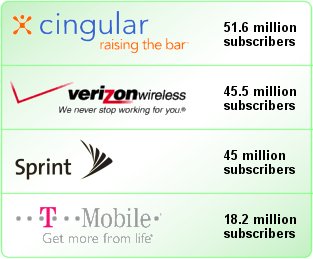|  It’s
about two years after Cingular acquired AT&T Wireless.
The real changes are just starting to take effect. Cingular
is spending 1.5 billion dollars on network integration and
expansion. They are also retaining customers better than ever
before and adding new ones at very good rates. It’s
about two years after Cingular acquired AT&T Wireless.
The real changes are just starting to take effect. Cingular
is spending 1.5 billion dollars on network integration and
expansion. They are also retaining customers better than ever
before and adding new ones at very good rates.
Here in the Greater
Philadelphia region, which includes Philadelphia, Northeastern
Pennsylvania, and Central Pennsylvania, the network integration
is scheduled to be complete by the end of this year. Integrating
the new Cingular network (dubbed the Orange network) with
the AT&T Wireless legacy network (dubbed the Blue network)
will result in better coverage and less dropped calls. In
addition, Cingular is putting up 140 new towers in this region.
There
will be less dropped calls because when a Cingular phone switches
from an Orange to a Blue tower in mid call today, the call
is dropped. The software needed to hand off the call from
one network to the other is not yet implemented everywhere.
Cingular customers with newer 64K Subscriber Information Modules
(SIM cards) are programmed to do this. The user doesn't even
know this is happening unless their call gets dropped.
 New
Cingular SIM cards automatically pick the network with better
coverage. AT&T Wireless phone users, on the other hand,
can only manually switch from Blue to Orange. AT&T Wireless
phones favor the Blue network. So, even when the Orange network
signal is better, AT&T phones will hang onto the Blue
network. The only time when an AT&T Wireless phone will
connect to the Orange network is when the phone cannot find
the Blue network at all. New
Cingular SIM cards automatically pick the network with better
coverage. AT&T Wireless phone users, on the other hand,
can only manually switch from Blue to Orange. AT&T Wireless
phones favor the Blue network. So, even when the Orange network
signal is better, AT&T phones will hang onto the Blue
network. The only time when an AT&T Wireless phone will
connect to the Orange network is when the phone cannot find
the Blue network at all.
Leveraging the
strengths of both the Orange and Blue networks will result
in even greater coverage. From personal experience, I can
attest to the fact that my AT&T Wireless phone has benefited
from the drastic improvement in service. Cingular is not only
investing in its new network, they have also invested in the
Blue network as well. This makes sense, because the Blue and
Orange networks will become one eventually. In the Greater
Philly area alone, Cingular is spending 200 million dollars
on 140 new towers and network integration.
There
are some downsides to Cingular, however. As of June 1st, new
migration rules took affect in the Eastern and Western markets.
From that point on, subscribers with a Cingular or AT&T
Wireless plan are not allowed to purchase new phones at the
special prices for new subscribers until near the end of their
contracts. This means if you have a two year contract, like
me, you would have to pay full price for a new Cingular phone,
unless you was 20 out of 24 months into your contract. For
one year contracts it is 10 out of 12 months. AT&T Wireless
would have never done that to its customers. AT&T Wireless
customers were always able to take advantage of the same deals
that new subscribers get. The reason given for this rule by
a Cingular salesperson is that Cingular was loosing money
because too many AT&T Wireless subscribers were switching
to Cingular plans.
The Cingular
takeover of AT&T Wireless networks has its pluses and
minuses. The major plus is the drastic improvement in network
coverage and capacity. Overall, I think that the takeover
was a good thing for customers of both companies, especially
Cingular customers.
Related
Links:
• cingular.com
|


